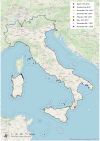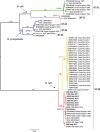Occurrence of Brucella ceti in striped dolphins from Italian Seas
- PMID: 33007030
- PMCID: PMC7531818
- DOI: 10.1371/journal.pone.0240178
Occurrence of Brucella ceti in striped dolphins from Italian Seas
Abstract
Brucella ceti infections have been increasingly reported in cetaceans, although a very limited characterization of Mediterranean Brucella spp. isolates has been previously reported and relatively few data exist about brucellosis among cetaceans in Italy. To address this gap, we studied 8 cases of B. ceti infection in striped dolphins (Stenella coeruleoalba) stranded along the Italian coastline from 2012 to 2018, investigated thanks to the Italian surveillance activity on stranded cetaceans. We focused on cases of stranding in eastern and western Italian seas, occurred along the Apulia (N = 6), Liguria (N = 1) and Calabria (N = 1) coastlines, through the analysis of gross and microscopic findings, the results of microbiological, biomolecular and serological investigations, as well as the detection of other relevant pathogens. The comparative genomic analysis used whole genome sequences of B. ceti from Italy paired with the publicly available complete genomes. Pathological changes consistent with B. ceti infection were detected in the central nervous system of 7 animals, showing non-suppurative meningoencephalitis. In 4 cases severe coinfections were detected, mostly involving Dolphin Morbillivirus (DMV). The severity of B. ceti-associated lesions supports the role of this microbial agent as a primary neurotropic pathogen for striped dolphins. We classified the 8 isolates into the common sequence type 26 (ST-26). Whole genome SNP analysis showed that the strains from Italy clustered into two genetically distinct clades. The first clade comprised exclusively the isolates from Ionian and Adriatic Seas, while the second one included the strain from the Ligurian Sea and those from the Catalonian coast. Plotting these clades onto the geographic map suggests a link between their phylogeny and topographical distribution. These results represent the first extensive characterization of B. ceti isolated from Italian waters reported to date and show the usefulness of WGS for understanding of the evolution of this emerging pathogen.
Conflict of interest statement
The authors have declared that no competing interests exist.
Figures



Similar articles
-
Brucella ceti Infection in Striped Dolphins from Italian Seas: Associated Lesions and Epidemiological Data.Pathogens. 2023 Aug 13;12(8):1034. doi: 10.3390/pathogens12081034. Pathogens. 2023. PMID: 37623994 Free PMC article.
-
Brucella ceti from two striped dolphins stranded on the Apulia coastline, Italy.J Med Microbiol. 2014 Feb;63(Pt 2):325-329. doi: 10.1099/jmm.0.065672-0. Epub 2013 Dec 9. J Med Microbiol. 2014. PMID: 24324028
-
Brucella ceti infection in dolphins from the Western Mediterranean sea.BMC Vet Res. 2014 Sep 17;10:206. doi: 10.1186/s12917-014-0206-7. BMC Vet Res. 2014. PMID: 25224818 Free PMC article.
-
Brucella ceti and brucellosis in cetaceans.Front Cell Infect Microbiol. 2012 Feb 6;2:3. doi: 10.3389/fcimb.2012.00003. eCollection 2012. Front Cell Infect Microbiol. 2012. PMID: 22919595 Free PMC article. Review.
-
Central Nervous System Disorders of Marine Mammals: Models for Human Disease?Pathogens. 2024 Aug 14;13(8):684. doi: 10.3390/pathogens13080684. Pathogens. 2024. PMID: 39204284 Free PMC article. Review.
Cited by
-
Toxoplasma gondii Genetic Diversity in Mediterranean Dolphins.Pathogens. 2022 Aug 12;11(8):909. doi: 10.3390/pathogens11080909. Pathogens. 2022. PMID: 36015030 Free PMC article.
-
Brucellosis in Marine Mammals: Meta-Analysis of Prevalence, Infection Patterns, Host Specificity and Zoonotic Potential.Vet Med Sci. 2025 Sep;11(5):e70557. doi: 10.1002/vms3.70557. Vet Med Sci. 2025. PMID: 40788178 Free PMC article. Review.
-
Combination of in silico and molecular techniques for discrimination and virulence characterization of marine Brucella ceti and Brucella pinnipedialis.Front Microbiol. 2024 Sep 18;15:1437408. doi: 10.3389/fmicb.2024.1437408. eCollection 2024. Front Microbiol. 2024. PMID: 39360323 Free PMC article.
-
Neuropathological Characterization of Dolphin Morbillivirus Infection in Cetaceans Stranded in Italy.Animals (Basel). 2022 Feb 12;12(4):452. doi: 10.3390/ani12040452. Animals (Basel). 2022. PMID: 35203160 Free PMC article.
-
Brucella ceti and Brucella pinnipedialis genome characterization unveils genetic features that highlight their zoonotic potential.Microbiologyopen. 2022 Oct;11(5):e1329. doi: 10.1002/mbo3.1329. Microbiologyopen. 2022. PMID: 36314752 Free PMC article.
References
-
- Corbel MJ. Brucellosis in humans and animals. World Health Organization. 2006. https://apps.who.int/iris/handle/10665/43597
Publication types
MeSH terms
Supplementary concepts
LinkOut - more resources
Full Text Sources
Miscellaneous

